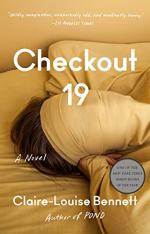|
This section contains 823 words (approx. 3 pages at 400 words per page) |

|
Checkout 19 Summary & Study Guide Description
Checkout 19 Summary & Study Guide includes comprehensive information and analysis to help you understand the book. This study guide contains the following sections:
This detailed literature summary also contains Quotes and a Free Quiz on Checkout 19 by Claire-Louise Bennett.
The following version of this book was used to create the guide: Bennett, Claire-Louise. Checkout 19. Penguin Random House UK, 2022.
Claire-Louise Bennett's novel Checkout 19 depicts the life and experiences of an unnamed female writer. While she is the sole narrator of the novel, she toggles between the first person plural, first person singular, third person, and second person points of view throughout. Her resistance to settling upon one narrative vantage enacts the narrator's search for self-actualization. Indeed, throughout her account, the narrator is searching her memories for clues to her most essential self. The novel rebels against traditional notions of the linear narrative plot line, obscuring conventions of structure and form, and blurring the boundaries between the real and the imagined, the remembered and the lived. For the sake of clarity, the following summary adheres to a more regular mode of explanation.
In Chapter I, "A Silly Business," the narrator recalls her childhood reading habits. She spent the majority of her time with books. She took books with her out to the lawn. She would lie in the grass and read. She would visit the library regularly. Sometimes she took out stacks of books at once, while at other times she would only check out one book at a time. She was good at simply sitting with books and letting their proximity edify her. There were few books in her home, as her parents had them hidden inside forbidden pieces of furniture. Despite the seeming secret nature of books, reading defined the narrator's life, reality, and identity.
In Chapter II, "Bright Spark," the narrator recalls her memories from grade school. She particularly enjoyed her classes with Mr. Burton. Everyone loved Mr. Burton, because he was funny and entertaining. However, the more camaraderie he shared with the narrator's male classmates, the more she came to disdain him. In order to punish him, she instigated a prank, in which she and her classmates stole the books he had managed to collect from the students at the term's end.
Feeling guilty for the prank, the narrator visited Mr. Burton's office to apologize. During this meeting, Mr. Burton revealed that he had discovered the narrator's secret drawings and writings in the back of her exercise notebook, and requested to see more. The stories the narrator shared with him over the course of the following weeks made her feel close to her teacher.
In Chapter III, "Won't You Bring In The Birds?," ever since the narrator's ex-boyfriend destroyed her unfinished manuscript, she has been trying to reconstruct the story. The story was about a man named Tarquin Superbus. In the story, Superbus acquires an extensive library. Because he is so delighted by the library, he is shocked when his friend, the Doctor, informs him that all of the books are empty, but for a single sentence. Although the Doctor finds the sentence, Superbus can locate it nowhere. Overcome by frustration, Superbus lights all of the books on fire.
The narrator admits that her memory of the Superbus tale is probably inaccurate. It has been many years since she wrote the story, and she has read and written many things since. She goes on to detail all of the books she has read over the years, and the manner in which each one impacted her. These books not only saved her life on many occasions, but clarified and authenticated her most ineffable emotional experiences.
In Chapter IV, "Until Forever," the narrator recalls the stories and drawings she once hid in the back of her school exercise notebooks. She particularly remembers drawing a man's portrait. This drawing later inspired her story about a girl locked in a room forced to sew her sisters' dresses for all eternity. Remembering this girl from her old story makes the narrator realize there is nothing worse for a woman than being without agency or freedom.
In Chapter V, "All Things Nice," while the narrator was attending university in London, she worked at a supermarket. A Russian man used to frequent the store and always came to her register. To survive the monotony, the narrator would daydream about the man.
In Chapter VI, "We Were the Drama," the narrator reflects on her anxiety and depression over the years. Recalling a series of experiences at home and abroad, the narrator realizes that when a woman feels confined or belittled, when her inner and outer worlds abrade one another, she will write elliptical prose.
In Chapter VII, "Woman Out of Nowhere," the narrator rents an attic room in a house owned by a woman with two daughters. Her tenure in the room grants the narrator the freedom to live and write the way she wants to. Although she initially worries about how others might perceive her habits, she eventually dispels these concerns. She casts off the societal and literary trappings that have limited her throughout her life, and writes simply of and for herself.
Read more from the Study Guide
|
This section contains 823 words (approx. 3 pages at 400 words per page) |

|



